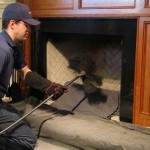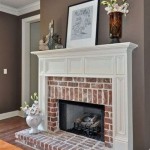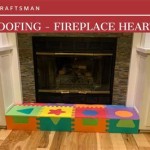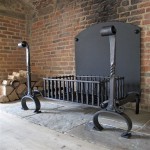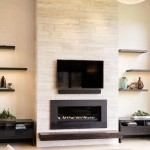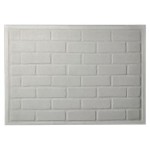Decorative Tile for Fireplace Enhancement
The fireplace, historically a central gathering point and a source of warmth, has evolved into a prominent design feature in many homes. Decorative tile plays a crucial role in enhancing the aesthetic appeal of a fireplace, transforming it from a functional element into a statement piece. The selection of decorative tile for a fireplace requires careful consideration of factors such as style, material, durability, and overall design coherence with the surrounding space. This article explores the various aspects of incorporating decorative tile into fireplace design.
The application of decorative tile to a fireplace is not merely an aesthetic choice; it also contributes to the fireplace's longevity and ease of maintenance. Tile provides a protective barrier against the heat generated by the fire, preventing damage to the underlying structure. Furthermore, tile surfaces are typically easy to clean, resisting stains from soot and ash. The range of available tile materials, colors, and patterns offers homeowners extensive design flexibility to personalize their living spaces.
Understanding Tile Materials and Their Characteristics
The choice of tile material is paramount when designing a fireplace surround. Different materials offer varying degrees of heat resistance, durability, and aesthetic appeal. Common tile materials include ceramic, porcelain, natural stone, and glass.
Ceramic tile is a popular and cost-effective option. It is relatively easy to install and available in a wide array of colors, patterns, and sizes. Ceramic tile is suitable for fireplace surrounds but may not be ideal for surfaces directly exposed to intense heat, such as the firebox interior. Its lower density compared to porcelain makes it less resistant to moisture and cracking under extreme temperature fluctuations.
Porcelain tile, a denser and more durable alternative to ceramic, is highly resistant to heat, water, and staining. Its superior strength makes it suitable for fireplace applications where direct heat exposure is a concern. Porcelain tile can mimic the appearance of natural stone, wood, or other materials, offering a versatile design solution. The manufacturing process allows for intricate patterns and textures, adding depth and visual interest to the fireplace surround.
Natural stone tiles, such as marble, granite, slate, and travertine, offer a timeless and luxurious aesthetic. Each stone type possesses unique veining, color variations, and textures, creating a one-of-a-kind fireplace. Natural stone is inherently durable and heat-resistant, making it a suitable choice for fireplace surrounds. However, some natural stones may require sealing to protect against staining and moisture absorption. Marble, in particular, is more porous and susceptible to staining compared to granite or slate.
Glass tile offers a contemporary and visually striking option. It can be used to create mosaic patterns, reflective surfaces, or vibrant color accents. Glass tile is non-porous and easy to clean, but its heat resistance may vary depending on the type of glass and its manufacturing process. Tempering the glass will improve resistance to high heats. It's important to select glass tile specifically designed for fireplace applications to ensure safety and longevity.
Design Considerations for Fireplace Tile
The design of the fireplace tile surround should complement the overall style of the room. Whether the aesthetic is traditional, modern, rustic, or eclectic, the tile selection should align with the existing decor and architectural features. Factors to consider include color palette, pattern, texture, and tile size.
Color plays a significant role in creating the desired mood and atmosphere. Neutral colors, such as white, beige, and gray, offer a timeless and versatile backdrop that can be easily integrated into various design schemes. Bold colors, such as deep blues, greens, or reds, can add a dramatic focal point to the room. The choice of grout color can also influence the overall appearance, either blending seamlessly with the tile or providing a contrasting accent.
Patterns and textures add visual interest and depth to the fireplace surround. Geometric patterns, such as herringbone, chevron, or subway tile, can create a contemporary and stylish look. Textured tiles, such as those with a raised or three-dimensional surface, add tactile appeal and visual dimension. Mosaic tiles offer endless possibilities for creating intricate patterns and designs.
Tile size should be proportional to the scale of the fireplace and the surrounding space. Large-format tiles can create a sleek and modern look, while smaller tiles are suitable for intricate patterns and detailed designs. The size of the tile can also affect the installation process and the amount of grout required.
Installation and Maintenance of Fireplace Tile
Proper installation is crucial to ensure the longevity and performance of the fireplace tile surround. It is recommended to hire a qualified tile contractor who has experience with fireplace installations. The installation process typically involves preparing the substrate, applying adhesive mortar, setting the tiles, and grouting the joints.
The substrate, or the surface to which the tile is applied, must be clean, level, and structurally sound. Depending on the existing surface, it may be necessary to install a cement backer board or other suitable underlayment to provide a stable and moisture-resistant base. The adhesive mortar should be specifically designed for fireplace applications and capable of withstanding high temperatures.
Setting the tiles requires careful attention to alignment, spacing, and levelness. Spacers are used to maintain consistent grout lines and ensure a uniform appearance. The grout should be selected to complement the tile and resist staining from soot and ash. After the grout has cured, it should be sealed to protect against moisture absorption and staining.
Regular maintenance is essential to keep the fireplace tile surround looking its best. Clean the tile surface regularly with a mild detergent and water to remove soot, ash, and other debris. Avoid using abrasive cleaners or scrub brushes that can scratch the tile surface. Inspect the grout lines periodically for cracks or damage and repair them promptly to prevent moisture penetration. Depending on the type of tile, it may be necessary to re-seal the surface periodically to maintain its water resistance and protect against staining.
By carefully considering the material, design, installation, and maintenance aspects of decorative tile, homeowners can create a stunning and functional fireplace that enhances the beauty and value of their homes.

Hot Fireplace Tile Trends Bedrosians Stone

Tile Stickers Fireplace Tiles For Kitchen Bathroom L New Zealand

47 Fireplace Tile Ideas Handmade Chic Surrounds
Fireplace Tile Surround 5 Decorative Mantel Tiles 2024

A Non Working Fireplace With Grey Star Patterned Tiles Around And On The Floor Refined White Frame An Home Design Surrounds
Fireplace Tile Surround 5 Decorative Mantel Tiles 2024

Decorative Ideas For Firewood Storage Places In The Home

Fireplace Tile Ideas Designs To Inspire You

Blue Fireplace Surround Tiles Design Ideas

7 Great Fireplace Tile Ideas Vertical Chimney Care



